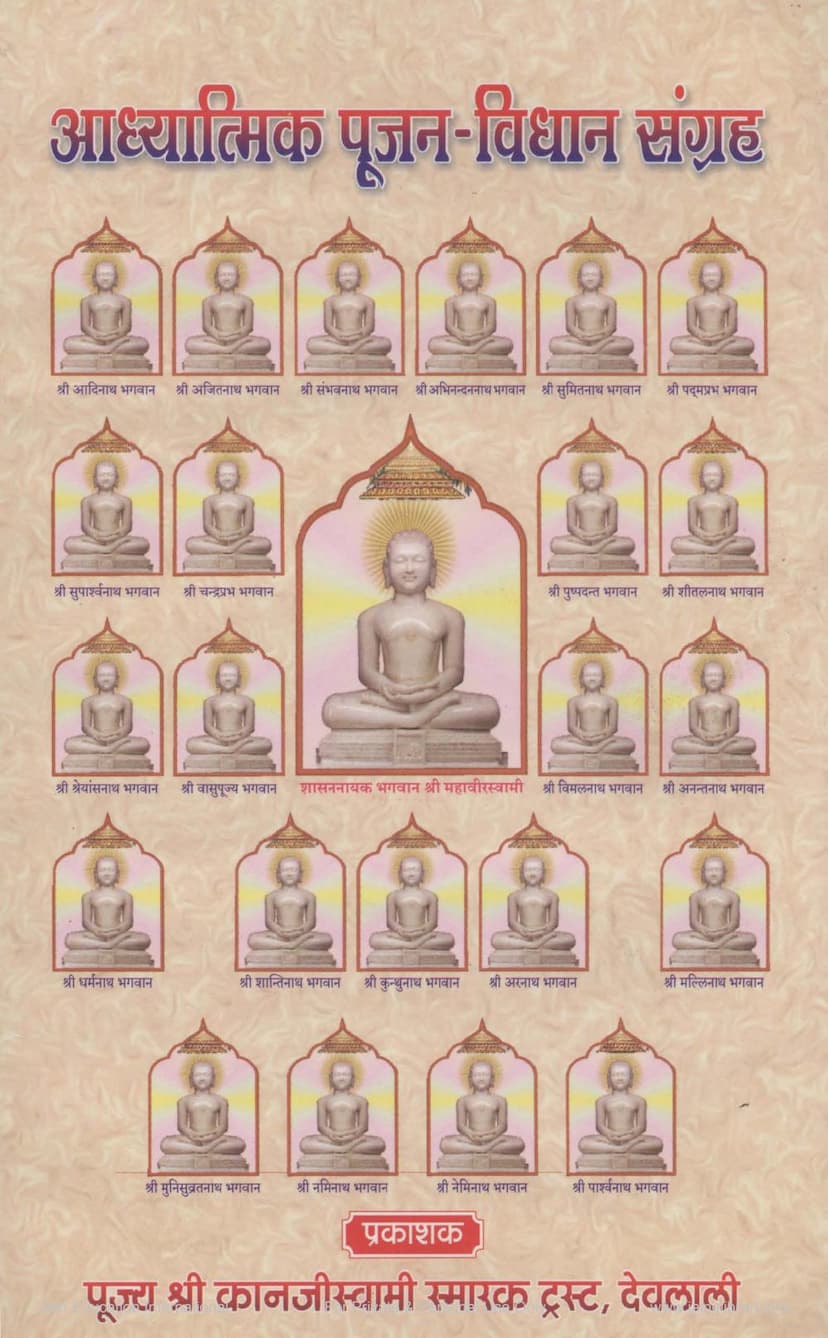Adhyatmik Poojan Vidhan Sangraha
Added to library: September 1, 2025

Summary
Certainly, here's a comprehensive summary of the Jain text "Adhyatmik Poojan Vidhan Sangraha" by Ravindra, published by Kanjiswami Smarak Trust:
Book Title: Adhyatmik Poojan Vidhan Sangraha (Collection of Spiritual Worship Procedures) Author: Bra. Shri Ravindra ji 'Atman' Publisher: Pujya Shri Kanjiswami Smarak Trust, Devlali
Overall Purpose and Theme:
This extensive collection, compiled and authored by Bra. Shri Ravindra ji 'Atman', is a comprehensive guide to spiritual worship within the Jain tradition. It focuses on the devotional practices (pooja and vidhan) dedicated to the twenty-four Tirthankaras, as well as other revered figures and principles of Jainism. The underlying theme is the elevation of the soul through devotion, leading to self-realization and spiritual liberation. The book emphasizes the "nishchay" (ultimate truth) perspective, aiming to connect devotional practices with profound Jain philosophical concepts.
Key Sections and Content Highlights:
The book is structured into multiple volumes (indicated by "Khand 1, 2, 3, and 4") and covers a wide range of worship rituals and hymns:
-
Tirthankara Worship (Main Focus):
- Twenty-Four Tirthankaras: The core of the collection is dedicated to the detailed worship procedures for each of the 24 Tirthankaras, from Shri Adinath Bhagwan to Shri Mahavir Bhagwan. Each Tirthankara has specific hymns (stuti) and worship rituals described.
- Specific Tirthankara Pujans: There are dedicated sections for pujans of groups of Tirthankaras like Shanti, Kunthu, and Aranath, and also for the Panchabalyati Tirthankaras (Vasupujya, Mallinath, Neminath, Parshvanath, and Mahavir).
- Vidyaman Twenty Tirthankaras: A special section is dedicated to the worship of the twenty Tirthankaras who reside in the Videh Kshetra (living Tirthankaras), led by Simandhar Swami.
- Twenty-Four Tirthankara Vidhan: The book includes a detailed "Vidhan" (ritualistic ceremony) for all 24 Tirthankaras, which is a more elaborate form of worship often performed over several days.
-
Worship of Core Jain Principles and Deities:
- Navadev Bhakti: Devotion to the Nine Treasures (Navadev) – Arihant, Siddha, Acharya, Upadhyaya, Sadhu, Dev (temple), Shastra (scriptures), Guru, and Dharma (religion).
- Dev-Shastra-Guru Pooja: Specific worship dedicated to the Three Jewels of Jainism.
- Veetaraag Pooja: Worship of the liberated souls (Arihants and Siddhas) who are free from attachment and aversion.
- Siddha Pooja: Worship dedicated to the liberated souls in their pure, omniscient state.
- Rishabha (Adinath) Bhagwan Pooja: A detailed section dedicated to the first Tirthankara, highlighting his significance.
- Bahubali Bhagwan Pooja: Worship of the heroic son of Adinath, known for his immense penance and detachment.
- Shrutpanchami Pooja: Worship associated with the sacred scriptures.
- Saraswati Pooja: Worship of the goddess of knowledge.
- Nandishwar Dweep Pooja: Worship of the sacred islands in the Jain cosmology, considered highly auspicious.
- Virshasan Jayanti Pooja: Worship commemorating the establishment of the Jain faith.
- Sixteen Karan Pooja: Worship related to the sixteen virtues or stages leading to Tirthankara status.
- Dashalakshan Dharma Pooja: Worship dedicated to the ten virtues of Jainism (forgiveness, humility, straightforwardness, contentment, purity, self-control, austerity, renunciation, detachment, and celibacy).
- Ratnatraya Pooja: Worship of the Three Jewels (Samyak Darshan, Samyak Gyan, Samyak Charitra).
- Panchameru Pooja: Worship of the five sacred mountains in Jain cosmology.
-
Ritualistic Elements:
- Abhishek Stuti: Hymns sung during the ritualistic bath (abhishek) of deities.
- Vidhan Peethika (Introduction to Rituals): Explanations and foundational verses for conducting the rituals.
- Visarjan Path: Prayers for the symbolic departure of the deities after the worship.
- Pratima Prahsal Path: Hymns for cleansing temple images.
- Vinay Path: Verses expressing humility and respect.
- Puja Pratigya Path: Vows taken before commencing worship.
- Maha Arghya and Samuchchay Jai Mala: Elaborate offerings and victory hymns.
-
Spiritual Insights and Philosophy:
- "Atman" (Self) as the Core: The author, Bra. Ravindra ji 'Atman', infuses the text with his deep spiritual understanding. The pujans and hymns aim to connect the devotee with their own true self (Atman).
- Emphasis on Nishchay Naya: The author and publisher (Pujya Shri Kanjiswami) are known for their strong emphasis on the ultimate truth (nishchay naya) of Jainism, seeking to convey the spiritual essence of these practices rather than mere external rituals. The foreword by Abhaykumar Jain highlights this focus on "Bhav Pradhan Poojan" (devotion-centric worship).
- Challenge to Misconceptions: The text addresses and corrects common misconceptions about worship, such as the purpose of offering materials and the true meaning of devotion.
- Integration of Philosophy: The worship verses often incorporate profound philosophical points like the distinction between the soul and the body, the nature of karma, and the path to liberation.
Author's Contribution and Style:
Bra. Shri Ravindra ji 'Atman' is lauded in the foreword for his profound spiritual insights, introspective nature, and eloquent discourses that balance spirituality, scripture, and practical life. His compositions are described as a confluence of devotion, spirituality, and doctrine, inspiring self-welfare. The writing style is noted for its deep devotionalभाव (bhava - emotional sentiment) and spiritual richness, encouraging readers to connect with the underlying philosophical truths.
Publisher's Mission:
Pujya Shri Kanjiswami Smarak Trust, Devlali, is dedicated to promoting the teachings and legacy of Pujya Shri Kanjiswami, a revered Jain scholar and preacher. This publication is part of their mission to disseminate spiritual knowledge and devotional literature within the Jain community.
Overall Significance:
"Adhyatmik Poojan Vidhan Sangraha" is a valuable resource for Jain devotees seeking to engage in meaningful and philosophically rich worship. It serves as a guide to understanding the spiritual depth behind the rituals and aims to foster a deeper connection with the Tirthankaras and the core principles of Jainism, ultimately leading towards self-realization and Moksha (liberation).